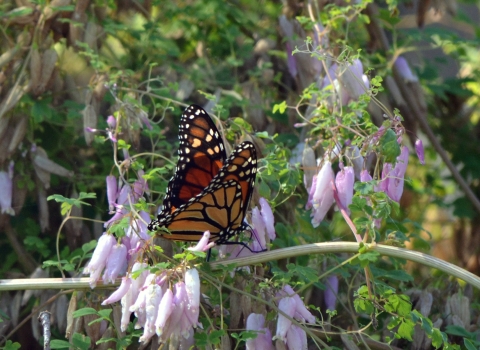Visit Us
National wildlife refuges offer everyone a chance to unplug from the stresses of daily life and reconnect with their natural surroundings. Green Bay National Wildlife Refuge contains beautiful island ecotypes and habitat that are rare elsewhere in Wisconsin and Michigan. These special communities support rare plants like dwarf lake iris and Canada yew, are home to colonial nesting birds and create vital migration stopovers for raptors, songbirds and waterfowl.
The Plum and Detroit Island units are open to the public Memorial Day through Labor Day, from sunrise to sunset. Plum Island is home to rare forest and coastal habitats, as well as a historic U.S. Coast Guard lifesaving and navigation station. The nearby Detroit Island unit has 148 acres that are open to the public for recreation, including hunting. These two refuge units can only be accessed by private boat, kayak or commercial charter. While other islands are closed to the public to protect habitats and species found there, views of the islands from the water provide ample opportunities to view wildlife and historic sites from a distance.
For general questions, please email GreenBayRefuge@fws.gov.
Location and Contact Information
About Us
Green Bay National Wildlife Refuge was established in 1912 to protect vital island habitat for species on the brink of extirpation or extinction. Now expanded to include six unique units, the refuge continues to conserve and protect rare and important habitats for plants and wildlife. The refuge is also home to one of the smallest federally-designated wilderness areas, Hog Island.
The refuge is now made up of the following six units:
- Hog Island, Wisconsin
- Plum Island, Wisconsin
- Pilot Island, Wisconsin
- A 148-acre parcel of land on Detroit Island, Wisconsin
- 1,260 acres of St. Martin Island, Michigan
- Rocky Island, Michigan
The Plum Island and Detroit Island units are open to the public from sunrise to sunset, Memorial Day through Labor Day annually. Please be aware of private property boundaries when visiting Detroit Island. The Detroit Island unit is also open to hunter access during state hunting seasons. All other islands of the refuge remain closed to the public for protection of colonial nesting birds and other species. The refuge is managed as part of the Horicon National Wildlife Refuge and Leopold Wetland Management District Complex.
Our Species
The refuge provides rare and important habitat to colonial nesting birds, rare and unique plant species and acts as a vital stopover for migrating birds every spring and fall. Herring gulls, great blue herons, black-crowned night herons, great egrets, white pelicans and double-crested cormorants use the islands to nest and raise their young. Bald eagles are known to nest on larger refuge islands, with many other raptors, warblers and songbirds - found in the forests of Plum and St. Martin Islands.
The islands also contain special habitats that are rare elsewhere in the Lake Michigan area, including coastal fens and alvars. These communities support rare plants like dwarf lake iris and Canada yew, making the refuge a unique opportunity for conservation and management.

